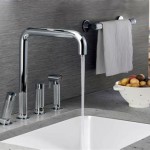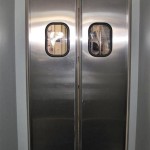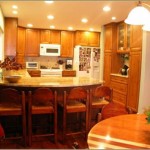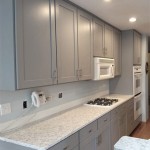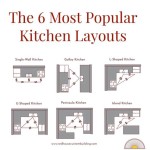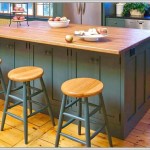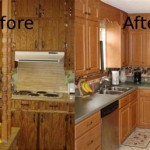Painting Ideas for Kitchen Cabinets: A Comprehensive Guide
Kitchen cabinets are a focal point of any kitchen, significantly impacting its overall aesthetic. Over time, cabinets can become dated, worn, or simply no longer align with evolving design preferences. Painting kitchen cabinets is a cost-effective alternative to replacement, offering a transformative update with the right preparation, materials, and techniques. This article explores various painting ideas for kitchen cabinets, providing insights into selecting colors, finishes, and styles to achieve desired results.
Preparation: The Foundation for a Flawless Finish
Proper preparation is paramount to achieving a professional-looking paint job on kitchen cabinets. This stage involves thorough cleaning, surface repair, and priming, ensuring optimal paint adhesion and a smooth, durable finish. Skipping or inadequately performing these steps can lead to peeling, chipping, and an overall subpar result. Therefore, dedicating sufficient time and attention to preparation is crucial.
The first step in preparing cabinets is removing all hardware, including knobs, pulls, hinges, and latches. This allows for unobstructed painting and prevents paint from adhering to the hardware. Store the hardware in a labeled container to avoid confusion during reinstallation. Following hardware removal, thoroughly clean the cabinet surfaces with a degreasing cleaner to remove grease, grime, and food residue. Commercial degreasers or a mixture of warm water and dish soap can be used. Rinse the cabinets with clean water and allow them to dry completely.
Next, inspect the cabinets for any damage, such as scratches, dents, or chips. These imperfections should be repaired before painting. Fill small imperfections with wood filler, applying it smoothly and evenly. Allow the filler to dry according to the manufacturer's instructions, then sand it flush with the surrounding surface using fine-grit sandpaper. For larger repairs, multiple applications of wood filler may be necessary, ensuring each layer is completely dry before sanding.
Sanding is a critical step in preparing cabinets for paint. Sanding creates a slightly rough surface, providing better adhesion for the primer and paint. Use medium-grit sandpaper (around 120-grit) to sand the entire surface of the cabinets, paying particular attention to areas with existing finish. Feather the edges of sanded areas to blend them seamlessly with the surrounding surface. After sanding, use fine-grit sandpaper (around 220-grit) to smooth the surface further. Remove all sanding dust with a tack cloth or a damp rag. Repeat the cleaning and sanding process as needed to ensure a clean, smooth, and uniformly prepared surface.
Priming is an essential step that should not be overlooked. Primer creates a uniform surface, seals the wood, and provides a better base for the paint to adhere to. Apply a high-quality primer specifically designed for use on wood or cabinets. Oil-based primers are generally recommended for cabinets as they offer excellent sealing and adhesion properties, but water-based primers are also suitable, especially if using water-based paint. Apply the primer in thin, even coats using a brush, roller, or sprayer. Allow the primer to dry completely according to the manufacturer's instructions before proceeding with painting. Lightly sand the primed surface with fine-grit sandpaper to remove any imperfections and create an even smoother surface for the paint.
Color Selection: Influencing the Kitchen's Atmosphere
The color of kitchen cabinets plays a pivotal role in shaping the kitchen's overall atmosphere and style. The choice of color should be based on personal preferences, the size and layout of the kitchen, and the desired aesthetic. Consider the existing elements in the kitchen, such as countertops, flooring, and backsplash, to ensure the cabinet color complements the overall design scheme.
White is a classic and versatile color choice for kitchen cabinets, offering a clean, bright, and timeless look. White cabinets can make a small kitchen appear larger and more airy. Different shades of white, such as off-white, cream, and antique white, can create varying degrees of warmth and sophistication. White cabinets pair well with a wide range of countertop materials and backsplash styles, making them a flexible option for various kitchen designs.
Gray is another popular color choice for kitchen cabinets, offering a sophisticated and modern aesthetic. Gray cabinets can range from light, airy shades to dark, dramatic hues. Light gray cabinets can create a calming and neutral backdrop, while dark gray cabinets can add depth and sophistication to the kitchen. Gray cabinets pair well with stainless steel appliances and natural stone countertops.
Blue cabinets are gaining popularity as a way to add a pop of color and personality to the kitchen. Blue cabinets can range from soft, muted blues to bold, vibrant shades. Light blue cabinets can create a coastal or cottage-style feel, while dark blue cabinets can add a touch of elegance and drama. Blue cabinets pair well with white or light-colored countertops and backsplash.
Green cabinets are an excellent choice for those who want to bring a touch of nature into the kitchen. Green cabinets can range from earthy, muted greens to vibrant, saturated shades. Light green cabinets can create a fresh and airy feel, while dark green cabinets can add a touch of sophistication and warmth. Green cabinets pair well with natural wood accents and copper hardware.
Two-tone cabinets are a design trend that involves painting the upper and lower cabinets in different colors. This can add visual interest and depth to the kitchen. A common approach is to paint the lower cabinets in a darker color and the upper cabinets in a lighter color. This can help ground the space and create a sense of balance. Experimenting with different color combinations can achieve a unique and personalized look.
Painting Techniques and Finishes: Achieving the Desired Look
The painting technique and finish used on kitchen cabinets significantly impact the final appearance and durability. Several painting techniques can be employed, each offering unique advantages. The choice of technique depends on personal preference, equipment availability, and the desired level of finish.
Brushing is a traditional painting technique that involves applying paint with a brush. Brushing is a versatile technique that can be used with both oil-based and water-based paints. It is particularly well-suited for painting intricate details and hard-to-reach areas. Choose a high-quality brush specifically designed for use with the chosen paint type. Apply the paint in thin, even coats, overlapping each stroke slightly to avoid streaks. Brushing may leave slight brushstrokes, adding a textured appearance to the finish.
Rolling is another common painting technique that involves applying paint with a roller. Rolling is a faster and more efficient technique than brushing, making it suitable for painting large, flat surfaces. Use a high-density foam roller for a smooth, even finish. Apply the paint in thin, even coats, overlapping each stroke slightly to avoid roller marks. Rolling typically results in a smoother finish than brushing, but it may not be as effective for painting intricate details.
Spraying is a painting technique that involves applying paint with a sprayer. Spraying is the most efficient way to achieve a smooth, flawless finish on kitchen cabinets. It requires specialized equipment, such as an airless sprayer or a HVLP (high-volume, low-pressure) sprayer. Spraying provides excellent coverage and minimizes brushstrokes or roller marks. However, it requires careful masking and ventilation to prevent overspray. Practice spraying on a test surface before applying paint to the cabinets.
The choice of paint finish is also crucial in determining the overall look and durability of the painted cabinets. Different paint finishes offer varying degrees of sheen, durability, and resistance to stains and scratches.
Matte finishes have a low sheen and are often used to create a soft, understated look. Matte finishes are less reflective and hide imperfections well. However, they are not as durable or easy to clean as other finishes. They are best suited for cabinets in low-traffic areas or for those who prefer a more casual aesthetic.
Satin finishes have a slight sheen and are a popular choice for kitchen cabinets. Satin finishes are more durable and easier to clean than matte finishes. They offer a good balance between aesthetics and practicality. Satin finishes are well-suited for a wide range of kitchen styles.
Semi-gloss finishes have a higher sheen than satin finishes and are very durable and easy to clean. Semi-gloss finishes are often used in kitchens and bathrooms where moisture resistance is important. They offer a sleek, modern look but can highlight imperfections more easily than matte or satin finishes.
High-gloss finishes have the highest sheen and are the most durable and easiest to clean. High-gloss finishes create a reflective, mirror-like surface that can add a touch of glamour to the kitchen. However, they are also the most likely to show imperfections. They are best suited for modern or contemporary kitchens or for those who want a bold, statement-making look.
In addition to the paint finish, applying a clear topcoat can enhance the durability and longevity of the painted cabinets. A clear topcoat provides an added layer of protection against scratches, stains, and moisture. Choose a water-based or oil-based topcoat that is compatible with the chosen paint type. Apply the topcoat in thin, even coats, following the manufacturer's instructions.
:strip_icc()/painted-kitchen-cabinet-ideas-20-becca-interiors-southampton-0b04a571a07649deb33edae1e89d9c41.jpeg?strip=all)
29 Painted Kitchen Cabinet Ideas You Can Easily Copy

15 Best Painted Kitchen Cabinets Ideas For Transforming Your With Color

How To Choose Kitchen Cabinet Paint Colors

Kitchen Cabinet Paint Ideas

How To Paint Kitchen Cabinets

How To Paint Kitchen Cabinets Like The Pros

Two Color Kitchen Cabinets Ideas And Exact Paint Matches Painted Colors Cabinet Modern White

Painted Kitchen Cabinet Ideas Architectural Digest

20 Diy Painted Kichen Cabinet Ideas A Cultivated Nest

Favorite Kitchen Cabinet Paint Colors
Related Posts

